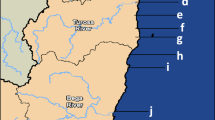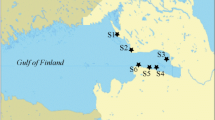Abstract
A study of contamination of the biological compartment of the Seine estuary was carried out by measuring the concentrations of cadmium (Cd), copper (Cu), lead (Pb), and zinc (Zn) in 29 estuarine and marine species belonging to 6 phyla. Species came from three main biological zones of the estuary: the Seine channel (copepods, mysids, shrimps, and fish), the intertidal mudflats (Macoma balthica community), and the subtidal mudflats (Abra alba community). Two fish species, the bass (Dicentrarchus labrax) and the flounder (Platichthys flesus), were also selected for analyses. A comparison of metal concentrations in estuarine species of the Seine with those found in the same species collected on contaminated and non-contaminated sites showed a contamination of the estuary by Cu, Zn, and Pb. For Cd, the contamination is mainly observed in bivalves, although the concentrations observed were low and less than 2 μg g−1 d.w. High concentrations of Cu were found in copepods, shrimps, and fish. Pb contamination was mainly found in species living in the Seine channel where the copepodEurytemora affinis shows an average concentration of 22 μg g−1 d.w. High concentrations of Pb (>10 μg g−1 d.w.) were found in deposit-feeders benthic invertebrates. Elevated levels of Zn were seen in all species collected in the Seine estuary, including fish and in particular small flounder. The concentrations of Cd, Cu, Pb, and Zn found in edible estuarine species (shrimp and fish) were in the same order of magnitude than those found in fish and shrimps fished along the French coast.
Similar content being viewed by others
Literature Cited
Amiard, C., C. Amiard-Triquet, andC. Metayer. 1982. Distribution de quelques métaux (Cd, Cu, Pb, Zn) chez les organismes vivants de l’estuaire de la Loire et des zones côtières adjacentes.Bulletin des Sociétés Naturelles de l’Ouest de la France 4:153–167.
Amiard, J. C., C. Amiard-Triquet, C. Metayer, andJ. Marchand. 1980. Etude du transfert de Cd, Pb, Cu et Zn dans les chaînes trophiques néritiques et estuariennes. I. Etat dans l’estuaire de la Loire (France) au cours de l'été 1978.Water Research 14:665–673.
Amiard-Triquet, C., C. Metayer, andJ. C. Amiard. 1980. Etude du transfer de Cd, Pb, Cu et Zn dans les chaînes trophiques néritiques et estuariennes. II. Accumulation biologique chez les poissons planctonophages.Water Research 14:1327–1332.
Anonymous, 1995. Surveillance du Milieu Marin, Travaux du RNO, édition 1995. IFREMER et Ministère de l’Environnement, Nantes, Paris.
Baretta, J. W. andJ. E. P. Malschaert. 1988. Distribution and abundance of zooplankton of the Ems estuary (North Sea),Netherland Journal of Sea Research 22:69–81.
Bessineton, C., C. Vedieu, and S. Simon. 1997. Réseaux trophiques du bar (Dicentrarchus labrax) et du flet (Platichthys flesus) première approche quantitative, Rapport 1997/Fin-4. Programme Scientifique Seine Aval, Thème Édifices Biologiques, Rouen.
Bietz, H., F. R. Mattig, P. H. Becker, andU. Ballin. 1997. Spatial and temporal variation in heavy metal contamination ofNereis andCerastoderma in the wadden sea.Archives Fisheries of Marine Research 45:243–254.
Bordin, G., J. McCourt, andA. Rodriguez. 1992. Trace metals in the marine bivalveMacoma balthica in the Westerschelde estuary (The Netherlands). Part 1: Analysis of total copper, cadmium, zinc and iron concentrations locational and seasonal variations.The Science of the Total Environment 127:255–280.
Boutier, B., J. F. Chiffoleau, D. Auger, andI. Truquet. 1993. Influence of the Loire River on dissolved lead and cadmium concentrations in coastal wasters of Brittany.Estuarine Coastal and Shelf Science 36:133–145.
Boutier, B., J. F. Chiffoleau, J. M. Jouanneau, C. Latouche, andI. Philipps. 1989. La Contamination de la Gironde Par le Cadmium, Origine, Extension, Importance. IFREMER, Plouzané.
Bryan, G. W. 1984. Pollution due to heavy metals and their compounds.Marine Ecology Progress Series 5:1289–1431.
Bryan, G. W. andW. J. Langston. 1992. Bioavailability, accumulation and effects of heavy metals in sediments with special reference to United Kingdom estuaries: A review.Environnemental Pollution 76:89–131.
Bryan, G. W., W. J. Langston, andL. G. Hummerstone. 1980. The use of biological indicators of heavy metal contamination in estuaries with special reference to an assessment of the biological availability of metals in estuarine sediments from south west Britain.Journal of Marine Biological Association of United Kingdom 1:1–73.
Cain, D. andS. N. Luoma. 1990. Influence of seasonal growth, age and environmental exposure on Cu and Ag in a bivalve indicator,Macoma balthica in San Fransisco Bay.Marine Ecology Progress Series 60:45–55.
Carral, E., X. Puente, R. Villares, andA. Carballeira. 1995. Background heavy metal levels in estuarine sediments and organisms in Galicia (NW spain) as determined by modal analysis.The Science of the Total Environment 172:175–188.
Castel, J. 1981. Aspects de l'étude écologique du plancton de l’estuaire de la Gironde.Océanis 3:535–577.
Chiffoleau, J. F., D. Cossa, D. Auger, andI. Truquet. 1994. Trace metal distribution, partition and fluxes in the Seine estuary (France) in low discharge regime.Marine Chemistry 47: 145–158.
Chiffoleau, J. F., P. Michel, D. Cossa, D. Auger, B. Averty, E. Chartier, J. Sanjuan, and I. Truquet. 1996. Distribution des contaminants métalliques dans l’estuaire de Seine en période de crue (Février 1995). Rapport 1995/Fin-3. Programme Scientifique Seine-Aval, Thème Chimie des Contaminants, Rouen.
Cossa, D., D. Auger, B. Averty, M. Luçon, P. Masselin, J. Noêl, and J. Sanjuan. 1990. Niveaux de Concentrations en Métaux, Métalloïdes et Composés Organochlorés dans les Produits de la Pêche Côtière Française. Rapports Scientifiques et Techniques de l’IFREMER, Brest.
Cossa, D., F. Elbaz-Poulichet, M. Gnassia-Barelli, andM. Roméo. 1993. Le plomb en milieu marin biogéochimie et ecotoxicologie. IFREMER, Nantes.
Dauvin, J. C. andJ. C. Lorgeré. 1989. Modifications du traîneau Macer-GIROQ pour l’amélioration de l'échantillonnage quantitatif étagé de la faune suprabenthique.Journal de Recherche Océanographique 14:65–67.
Dauvin, J. C., J. C. Sorbe, andJ. C. Lorgeré. 1995. The benthic boundary layer macrofauna from the upper continental slope and the Cap Ferret canyon (Bay of Biscay).Oceanologica Acta 18:113–122.
Ferchaud, R. 1998. Etude du cadmium dans les mollusques des gisements naturels du littoral de Charente-Maritime, (utilisation de la coque communeCerastoderma edule et de l’huître creuseCrassostrea gigas comme indicateurs quantitatifs), apports dans la ration alimentaire. Mémoire de diplôme ingénieur CNAM, Nantes.
Greig, R. A.,N.A. Adams, andG. R. Wenzloff. 1977. Trace metal content of plankton and zooplankton collected from the New-York Bright and Long Island Sound.Bulletin of Environmental Contamination and Toxicology 18:3–8.
Hardstedt-Romeo, M. andF. Laumond. 1980. Zinc, copper and cadmium in zooplankton from the NW Mediterranean.Marine Pollution Bulletin 11:133–138.
Jouanneau, K. M., B. Boutier, J. F. Chiffoleau, C. Latouche, andI. Phillips 1990. Cadmium in the Gironde fluvioestuarine system: Behaviour and flow.The Science of the Total Environment 97/98:465–479.
Langston, W. J. 1986. Metals in sediment and benthic organisms in the Mersey estuary.Estuarine Coastal and Shelf Sciences 23:239–261.
Luoma, S. N., D. Cain, andC. Johansson. 1985. Temporal fluctuations of silver, copper and zinc in the bivalveMacoma balthica at five stations in South San Fransisco Bay.Hydrobiologia 129:109–120.
Marchand, J. 1981. Observations sur l'écologie deCrangon crangon (Linné) etPalaemon longirostris (H. Milne Edwards) (crustacea, Decapoda, Natantia). Estuaire interne de la Loire (France).Vie et Milieu 31:83–92.
Mattig, F. R., U. Ballin, H. Bietz, K. Giessing, P. Kruse, andP. Becker. 1997. Organochlorines and heavy metals in benthic invertebrates and fish from the back barrier of Spierkeroog.Archives Fisheries of Marine Research 45:113–133.
Mayer, L. M., Z. Chen, R. N. Findlay, J. Fang, S. Sampson, R. F. L. Self, P. A. Jumars, C. Quetel, andO. F. X. Donard. 1996. Bioavailability of sedimentary contaminants subject to deposit-feeder digestion.Environmental Science and Technology 30:2640–2645.
McLeese, D. W. andS. Ray. 1984. Uptake and excretion of cadmium, Cd EDTA and zinc byMacoma balthica.Bulletin of Environmental Contamination and Toxicology 32:85–92.
Mees, J. 1994. The hyperbenthos of shallow coastal waters and estuaries: Community structure and biology of the dominant species. Thesis, Universiteit Gent, France.
Mees, J. N., N. Fockedey, andO. Hamerlynck. 1995. Comparative study of the suprabenthos of three European estuaries.Hydrobiologia 311:153–174.
Miramand, P., D. Bentley, J. C. Guary, andJ. M. Brylinski. 1993. Rôle du plancton dans le cycle biogéo chimique du cadmium et du vanadium en baie de Seine Orienale: Premiers résultats.Océanologica Acta 16:625–632.
Miramand, P., D. Fichet, D. Bentley, J. C. Guary, andF. Caurant. 1998. Concentrations en métaux lourds (Cd, Cu, Pb, Zn) observées le long du gradient de salinité dans le réseau trophique pélagique de l’estuaire de la Seine.Comptes Rendus de l’Académie des Sciences de Paris, Sciences de la Terre et des Planètes 327:259–264.
Miramand, P., M. Lafaurie, S. W. Fowler, P. Lemaire, J. C. Guary, andD. Bentley. 1991. Reproductive cycle and heavy metals in the organs of red mullet, Mullus barbatus (L.) from the north western Mediterranean.The Science of the Total Environment 103:47–56.
Mouny, P. 1998. Structure spatiotemporelle du zooplancton et du suprabenthos de l’estuaire de la Seine. Dynamique et rôle des principales espèces dans la chaîne trophique pélagique. Thèse de doctorat, Museum National d’Histoire Naturelle, Paris.
Mouny, P., J. C. Dauvin, C. Bessineton, B. Elkaïm, andS. Simon. 1998. Spatio-temporal patterns of the biological components from the Seine estuary: First results.Hydrobiologia 373/374:333–347.
Mouny, P., Z. Wang, andJ. C. Dauvin. 1996. Premières données sur la structure spatiotemporelle du mésozooplancton et du suprabenthos de l’estuaire de la Seine.Journal de Recherche Océanographique 21:109–117.
Packer, D. M., M. P. Ireland, andR. J. Wootton. 1980. Cadmium, copper, lead zinc and manganese in the polychaeteArenicola marina from sediment around the coast of wales.Environnmental Pollution 22:309–321.
Ritterhoff, J. andG. P. Zauke. 1997. Trace metals in field samples of zooplankton from the Fram Strait and the Greeland Sea.The Science of the Total Environment 199:255–270.
Rochard, E., P. Boet, G. Castelnaud, F. Gauthiez, J. F. Bigot, andB. Ballion. 1996. Premier inventaire ichtyologique de la partie basse de la Seine. Rapport 1996/Fin-4. Programme Scientifique Seine Aval, Thèmes Édifices Biologíques, Rouen.
Rybarczyk, H., J. D. Talleux, N. Loquet, andB. Elkaïm. 1996. Analyse comparative des bilans énergétiques et de la composition biochimique des principales espèces des peuplements benthiques de la baie de Seine. Rapport 1996/Fin-4. Programme Scientifique Seine Aval, Thèmes Édifices Biologiques, Rouen.
Rybarczyk, H., J. D. Talleux, N. Loquet, E. Loirat, andB. Elkaïm. 1997. Analyse comparative des bilans énergétiques et de la composition biochimique des principales espèces des peuplements benthiques de la baie de Seine. Rapport 1997/Fin-4. Programme Scientifique Seine Aval, Thèmes Édifices Biologiques, Rouen.
Saiz-Salinas, J. I., J. M. Ruiz, andG. Frances-Zubillaga. 1996. Heavy metal levels in intertidal sediments and biota from the Bidasoa estuary.Marine Pollution Bulletin 32:69–71.
Soetaert, K. andP. Van Rijswijk. 1993. Spatial and temporal patterns of the zooplankton in the Neterschelde estuary.Marine Ecology Progress Series 97:47–59.
Sorbe, J. C. 1981. La macrofaune vagile de l’estuaire de la Gironde. Distribution et migration des espèces. Modes de reproduction. Régimes alimentaires.Océanis 6:579–592.
Szefer, P. andK. Szefer. 1990. Metals in molluscs and associated bottom sediments of the southern baltic.Helgoländer Meeresunlers 44:411–424.
Thomson, E. A., S. N. Luoma, C. E. Johansson, andD. J. Cain. 1984. Comparison of sediments and organisms in identifying sources of biologically available trace metal contamination.Water Research 6:755–765.
Zauke, G. P., M. Krause, andA. Weber. 1996. Trace metals in meso-zooplankton of the North Sea: Concentrations in different taxa and preliminary results on bio-accumulation in Copepod Collectives (Calanus finmarchicus/C. helgolandicus).International Revue of Gesamp Hydrobiology 81:141–160.
Author information
Authors and Affiliations
Corresponding author
Rights and permissions
About this article
Cite this article
Miramand, P., Guyot, T., Rybarczyk, H. et al. Contamination of the biological compartment in the Seine estuary by Cd, Cu, Pb, and Zn. Estuaries 24, 1056–1065 (2001). https://doi.org/10.2307/1353017
Received:
Accepted:
Issue Date:
DOI: https://doi.org/10.2307/1353017




